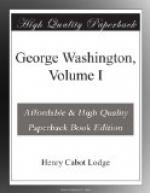skill to make it widely popular. It neither appealed
to nor was read by the cultivated and instructed few,
but it reached the homes of the masses of the people.
It found its way to the bench of the mechanic, to
the house of the farmer, to the log cabins of the frontiersman
and pioneer. It was carried across the continent
on the first waves of advancing settlement. Its
anecdotes and its simplicity of thought commended
it to children both at home and at school, and, passing
through edition after edition, its statements were
widely spread, and it colored insensibly the ideas
of hundreds of persons who never had heard even the
name of the author. To Weems we owe the anecdote
of the cherry-tree, and other tales of a similar nature.
He wrote with Dr. Beattie’s life of his son
before him as a model, and the result is that Washington
comes out in his pages a faultless prig. Whether
Weems intended it or not, that is the result which
he produced, and that is the Washington who was developed
from the wide sale of his book. When this idea
took definite and permanent shape it caused a reaction.
There was a revolt against it, for the hero thus engendered
had qualities which the national sense of humor could
not endure in silence. The consequence is, that
the Washington of Weems has afforded an endless theme
for joke and burlesque. Every professional American
humorist almost has tried his hand at it; and with
each recurring 22d of February the hard-worked jesters
of the daily newspapers take it up and make a little
fun out of it, sufficient for the day that is passing
over them. The opportunity is tempting, because
of the ease with which fun can be made when that fundamental
source of humor, a violent contrast, can be employed.
But there is no irreverence in it all, for the jest
is not aimed at the real Washington, but at the Washington
portrayed in the Weems biography. The worthy “rector
of Mount Vernon,” as he called himself, meant
no harm, and there is a good deal of truth, no doubt,
in his book. But the blameless and priggish boy,
and the equally faultless and uninteresting man, whom
he originated, have become in the process of development
a myth. So in its further development is the
Washington of the humorist a myth. Both alike
are utterly and crudely false. They resemble their
great original as much as Greenough’s classically
nude statue, exposed to the incongruities of the North
American climate, resembles in dress and appearance
the general of our armies and the first President of
the United States.
Such are the myth-makers. They are widely different from the critics who have assailed Washington in a sidelong way, and who can be better dealt with in a later chapter. These last bring charges which can be met; the myth-maker presents a vague conception, extremely difficult to handle because it is so elusive.




